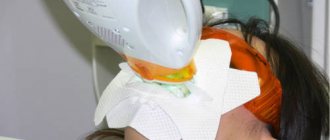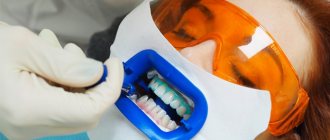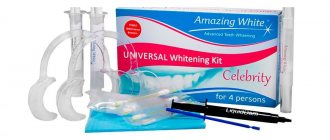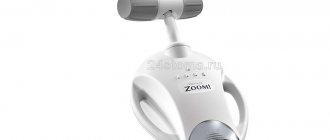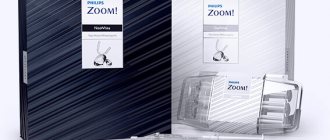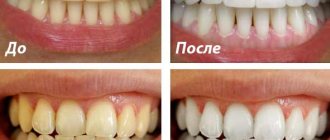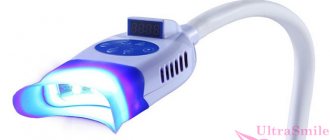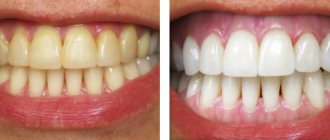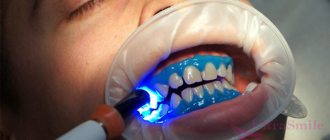Features of teeth whitening Zoom 4
Zoom technology is patented by Discus Dental. The essence of the method is as follows: a special gel is applied to the surface of the teeth, the action of which is activated by the light of an ultraviolet lamp. As a result of light exposure, oxygen molecules are released, which penetrate dental tissue and destroy coloring pigments.
Zoom 4 whitening technology, which is the latest version of Philips' development, features a number of solutions that significantly increase the comfort and safety of the procedure.
Contraindications
The procedure is safe, but it has several contraindications:
- age under 16 years;
- pregnancy and breastfeeding;
- taking certain medications;
- personal intolerance to the components included in the gel;
- oncology;
- presence of a pacemaker;
- mental disorders.
Also contraindicated are caries, diseases of the soft tissues of the oral cavity and other dental diseases.
Benefits of Philips Zoom 4 Teeth Whitening
The most effective and gentle whitening - under this motto, Philips launched its new product on the market. The Zoom 4 kit includes an LED lamp with various intensity settings, Philips ZOOM! Chairside, as well as Relief ACP tooth sensitivity reducer. Previous generation systems have a similar set of components. However, the old composition of the whitening gel could not be called ideal. In Zoom 4 it was seriously improved, which helped reduce the negative impact on dental tissue.
Is Zoom 4 teeth whitening harmful?
Any type of whitening is safe if it is performed by a qualified professional following protocol, as well as certified equipment and supplies.
pros
- The hydrogen peroxide content is 25%, which is the lowest level compared to previous Zoom systems.
- The whitening gel contains calcium phosphate to restore enamel.
- Philips ZOOM! Chairside does not overheat dental tissue and has a flexible system of settings.
- To prevent tooth sensitivity, an effective remedy is used - Relief ACP gel.
- The procedure takes on average no more than 45 minutes.
The whole truth about teeth whitening: from modern methods to good old Zoom
Nicole Kidman
Experts note that no matter how thoroughly we brush our teeth, over time a bacterial film forms on them, which darkens more and more over time - this is a natural process. Abuse of coffee, tea, foods with food dyes, and smoking aggravate the situation. SPLETNIK.RU talked to experts and found out what dental procedures will help you achieve a snow-white smile.
Molecular whitening
As dentist Dmitry Smirnov explains, in fact, this is deep polishing: it consists of removing the bacterial film from the teeth, due to which the enamel surface is cleaned. This procedure is carried out as part of regular oral hygiene.
Whitening occurs at the molecular level, so only “living” teeth can be whitened, that is, this technique will not work on veneers and porcelain crowns. The main contraindication is caries, since it can worsen after the procedure. Surprisingly, the more advanced the case (the yellower the natural shade), the better such teeth are amenable to whitening. But greyish, blue or pinkish colors are almost impossible to bleach.
Whitening occurs using a special gel based on hydrogen peroxide. Then a gel with amorphous calcium phosphate (ACP), fluorides and trace elements is applied. They are designed to reduce sensitivity and restore shine to teeth. The final stage is home care. Judging by reviews online, the effect of the procedure lasts for several years, and if you don’t drink coffee or red wine, you can enjoy a Hollywood smile for three years.
Chemical bleaching
All types of whitening are based on hydrogen peroxide. Sometimes the preparations include amorphous calcium phosphate, fluoride or potassium nitrate to treat minor damage to the enamel, as well as to make teeth brighter and glossier after the procedure. In some cases, the whitening gel may contain special components that have a soothing effect on the teeth and gums.
Activation of the gel, which whitens teeth, occurs by mixing two components. Individual mouth guards are made for the patient (if we are talking about professional chemical whitening), or the mouth guards can be universal (for home whitening).
The patient wears a mouthguard containing activated gel with a high content of hydrogen peroxide (40 percent hydrogen peroxide solution - a higher concentration than other systems). Professional chemical in-office whitening even involves whitening the inner surface of a specific tooth. It happens that all the teeth are light, and one is darkened, for example, from the inside. This bleaching gives a lightening effect of 5-10 tones, explains Dmitry Smirnov.
Chemical whitening allows you to keep your teeth white for two to five years, provided, of course, that you do not abuse strong tea, cigarettes, or wine (you should not consume foods with a strong coloring pigment: red berries and beets, for example). After whitening, fluoridation or remineralization procedures are often performed to reduce the risk of hypersensitivity and restore the enamel.
Ultrasonic whitening
This procedure is not actually teeth whitening - it is professional ultrasonic cleaning, one of the bonuses of which is easy lightening of the enamel. Using an ultrasonic device, soft plaque and hard stones are removed, after which the tooth is polished and coated with fluoride varnish.
Laser whitening
Laser whitening is already aesthetic, light whitening. It can be cold or hot, depending on the wavelength of the procedure. The gel is applied to the teeth and activated using a stream of light.
Laser whitening is fundamentally different from other types and is considered the most gentle. The laser radiation flux is very powerful and its exposure time is shorter than that of light. At the same time, laser whitening has an average degree of effectiveness. It is indicated for those patients who need to whiten a specific area on the tooth locally. For example, physiologically, human canines have a darker shade. To whiten them, laser whitening is just the way to go.
Everything will take about 30 to 40 minutes. This procedure is also suitable for patients with high sensitivity to temperature stimuli. But remember that two weeks after your first visit to the dentist, you may need to repeat the procedure to achieve a lighter shade.
Air Fiow is the same abrasive system that is used for professional hygiene. A sandblaster (it cleans with a jet of air under pressure with an abrasive, while simultaneously supplying water) removes the bacterial film from the surface of the tooth.
There are similar devices in every dental office, the only difference is in the manufacturers of this equipment. There are Chinese ones, the cost of which is literally two to three thousand rubles. And there are systems that are entire complexes with different powder dispersion and pressure. The cost of the latest generation Air Fiow device is about a million rubles, says the expert.
Photobleaching
To date, there have been four generations of Zoom, but two variants are currently in use - Zoom-3 and Zoom-4. It is considered to be the most powerful whitening system. Zoom-3 is a light whitening treatment that uses “hot” light. Under the influence of UV rays, active oxygen is released from the gel, which interacts with enamel pigments. It is effective, but has a side effect: during the procedure, the tissues overheat, which can lead to thermal injury to the tooth.
Zoom-4 is the most advanced technology that uses “cold” light. It allows you to whiten enamel by 18 tones, but without injury or the risk of overheating. The effect lasts up to three years.
It is worth noting that if you have a high degree of tooth sensitivity, then whitening may be contraindicated. Therefore, consultation with a qualified dentist is mandatory. There are certain areas on the teeth that are prone to the formation of a bacterial film; they are located in the duct of the salivary glands, which wash the oral cavity. Therefore, in most people, plaque forms more intensely on the inner surface of the lower front teeth, since this is where the duct of the sublingual salivary gland is located. Or plaque forms in the area of large teeth on the upper jaw, because there is a duct of the buccal salivary gland. Accordingly, if we regularly maintain high-quality professional hygiene and support it with additional dental procedures, providing the teeth with a highly smooth surface, then this plaque will form less intensively,
- explains the expert.
The dentist warns that those who try to solve the problem on their own may thereby harm themselves. Whitening toothpastes contain an abrasive - a derivative of soda. The tubes even indicate the dispersion index. If this index is higher than three, then the paste is highly abrasive. This abrasive partially removes the plaque, but in its place a rougher surface remains, to which a new bacterial film attaches faster, but here’s the catch - it will last even longer. Cleaning with such pastes gives a quick but short-lived result, which in the long term leads to a worsening of the problem.
Therefore, the best solution is a visit to the dentist, who will offer the type of whitening suitable for the patient; fortunately, there are many of them today.
Differences between Zoom 4 and Zoom 3
There are no conceptual differences between two generations of the same technology. It's all about the nuances.
✔
Firstly, all components and tools of Zoom 4 are from one manufacturer. Their maximum compatibility allows you to achieve the best results.
✔
Secondly, the Zoom 4 whitening gel contains a number of additional elements that reduce the negative impact on the enamel and promote its active restoration.
✔
In addition, Zoom 4 contains less hydrogen peroxide: 25% versus 35% in Zoom 3. This ten percent difference is very important. The alkaline composition, which is applied along with the gel, helps to minimize this impact.
Thanks to the balanced composition and the introduction of new developments, hypersensitivity after teeth whitening with the Zoom 4 system can be observed for only 7-10 hours, after which the patient practically does not feel any serious discomfort. In terms of safety, comfort and painlessness, Zoom 4 is superior to Zoom 3, not to mention earlier systems. On the other hand, the efficiency of Zoom 3 is about the same as that of Zoom 4.
Differences between Zoom 3 and Zoom 4 whitening
There are no fundamental differences between Zoom 3rd and 4th generations, however, dentists prefer the second: the risk of thermal burn has decreased to a minimum, and there is no need to apply a thick layer of protective cream. The main achievement is the transition from UV lamps to LED lamps.
| Options | Zoom 3 | Zoom 4 |
| Hydrogen peroxide concentration | 35% | 25% |
| Equipment | UV lamp | LED lamp (cold light) |
| Lightening effect | 7-8 tones | 7-8 tones, removes natural yellowness, brown stains from long-term smoking, coffee and tea |
| Duration | 1 session – 45-60 minutes | 1 session – 45-60 minutes |
| Side effects | Burns to the mucous membrane, increased sensitivity of teeth | None |
| Prevention | Has no prophylactic effect | The gel contains components that strengthen the enamel |
| Recovery period | Within 12 hours after whitening, tooth sensitivity increases, full recovery after 2-4 weeks | Within 12 hours after whitening, tooth sensitivity increases, full recovery after 2 weeks |
How does whitening with the Zoom 4 system work?
For the procedure to be effective, preparation for Zoom 4 teeth whitening involves professional hygiene. In order to prevent increased sensitivity of teeth, remineralizing therapy is also carried out in combination with brushing. One whitening session can consist of several cycles of 10-15 minutes. After whitening, Relief gel is applied to the enamel to reduce tooth sensitivity.
Indications and contraindications for teeth whitening
There is only one indication for whitening – the patient’s desire to make his teeth whiter. The Zoom 4 system allows you to lighten the enamel by more than 8 tones during one session. The technical specifications state numbers up to 15 tones, but in practice this is problematic.
The system showed the greatest effect on enamel darkening associated with food dyes and smoking. Average effectiveness is observed with fluorosis. But for color changes associated with the use of medications, Zoom 4 is ineffective.
Contraindications:
- Untreated carious lesions.
- The presence of fillings in the affected area - after the procedure, their color may differ from the color of the enamel, and they will most likely have to be replaced.
- Increased sensitivity of teeth.
- Gingivitis and stomatitis.
- Chips and other enamel defects.
- If you have a history of allergic reactions to any components of the gel.
- Taking photosensitizing drugs.
- Pregnancy and lactation period.
- Age under 18 years. Some clinics raise the age limit to 20 years.
Whitening results
Several factors influence how bright and light the shade of your teeth will be. The first is smoking. The more cigarettes a patient smokes, the sooner the teeth will darken from nicotine stains. To prevent this from happening, you should either give up the bad habit or regularly undergo professional cleaning.
The second factor is the innate shade of the enamel. There are 16 of them in total, and there are teeth that are very dark by nature. The darker the natural pigment, the more effort you will have to put into bleaching.
The third factor is illness or taking medications that affect the color of teeth (fluorosis, tetracycline antibiotics, etc.). Such stains may be difficult to whiten. The whitening result will last from 3 to 5 years, provided proper and regular care (home hygiene, professional cleaning every six months).
How often can I do ZUM whitening?
Only dentists can give the correct answer to this question. And in each individual case it will be different. On average, it is believed that ZUM whitening can be done no more than 1 – 2 times a year. How often the need to repeat the whitening procedure will arise depends on several factors:
- age of the patient (the older the patient, the faster the effect of the whitening procedure disappears);
- presence of bad habits (smoking);
- natural tooth color (naturally light teeth need to be whitened less frequently);
- quality of individual oral care (regular hygiene helps preserve the shade of tooth enamel).
Care and diet after teeth whitening Zoom 4
Any type of bleaching imposes a number of restrictions, the compliance with which directly determines the effectiveness of the procedure. In the case of Zoom 4 technology, it is very important to follow a diet after whitening is completed.
List of recommendations after whitening Zoom 4
- Eliminate from your diet all foods and drinks that tend to stain your teeth. First of all, these are coffee, tea, sweet carbonated drinks, wine, beets, carrots, ketchup and dark chocolate. It is advisable to avoid the above foods for at least a week.
- For two days, completely eliminate tobacco use. It is advisable to quit smoking for a month or at least significantly reduce the number of cigarettes per day.
- Comprehensive hygiene using floss, irrigator, high-quality toothbrush and toothpaste with minimal abrasiveness (at least during the recovery stage after whitening).
- Regular visits to the dentist for preventive examinations and professional hygiene.
Recommendations for maintaining whiteness
To maintain the effect obtained from the procedure, you should adhere to the following recommendations:
- You should not eat food for several hours. But you can drink regular, still water.
- It is advisable not to smoke for the first 72 hours after the procedure. And subsequently, it is better to give up this habit altogether or reduce the number of cigarettes you smoke, since nicotine and tobacco tar are the main causes of yellowing of teeth.
- Within 7 days after bleaching, you should exclude foods that cause strong pigmentation from the menu. These include beets and carrots, spinach, berries, red wine, coffee and tea. It is strictly forbidden to drink carbonated drinks such as “Cola”, “Tarragon”, “Baikal” at this time. They contain strong dyes that cause discoloration of teeth. In addition, sugar and gas contained in drinks can lead to the destruction of enamel, which is weakened after the procedure.
- It is advisable to add calcium-rich foods to your diet. These include fermented milk products, asparagus, lean white meat, and rice.
- The first 2 weeks should pay great attention to oral hygiene. Teeth should be brushed twice a day and mouthwash should be used after each meal. You will also need to use a waterpik and replace toothpicks with dental floss.
- To clean the mouth, you should use a paste containing calcium. It will strengthen the enamel and help it maintain its whiteness. It is also worth using soft brush options that do not cause microscopic damage to the enamel.
In the future, you should be careful about the condition of your oral cavity. It is necessary to visit the dentist every 6 months, and also at the slightest pain and discomfort, it is advisable to check your teeth for the development of caries and other diseases.
Prices for services
| Service | Price | Installment plan 0% monthly (x12) |
| Whitening ZOOM 4 (2 jaws) generation 2022 | 28500 rub. | RUB 2,350 |
| Professional teeth cleaning Clinpro | 6,900 rub. | — |
| Remineralization of teeth (entire cavity) | 2,800 rub. | — |
| Ultrasound removal of tartar (entire cavity) | 2,800 rub. | — |
Carrying out the procedure
The principle of whitening is to apply a gel with a concentration of hydrogen peroxide to the surface of the enamel. Depending on the whitening technique, preparations with different concentrations of hydrogen peroxide are used: Zoom 1 2 3 - 35%, Zoom 4 - 25%.
Before the procedure, the dentist examines the oral cavity, assesses the condition of the dental system, and determines the initial shade of the teeth. Doctors at the Mitino Dental Center recommend professional teeth cleaning to remove hard and soft plaque before teeth whitening.
The Zoom whitening procedure takes place in several successive stages:
- The lips and gums are treated with protective agents and isolated from the teeth with a rubber dam (latex plates).
- Tooth enamel is coated with a special Zoom compound and activated with an LED lamp. A cold light source prevents overheating of soft tissues. The stages of application and illumination are repeated three times. At each stage, the gel should remain on the teeth for no more than 10–15 minutes.
- The remaining gel is removed with cotton swabs, the teeth are washed with water, dried, the rubber dam is removed, and a remineralizing gel is applied.
When teeth are stained after nerve removal and canal filling, intracoronal bleaching is performed. In this case, a special cavity is filled with Zoom whitening gel and a temporary filling is installed. The pigment breaks down within 10–14 days, after which the temporary filling is replaced with a permanent one. The technique is applied to individual dental units, and not to the entire row.

